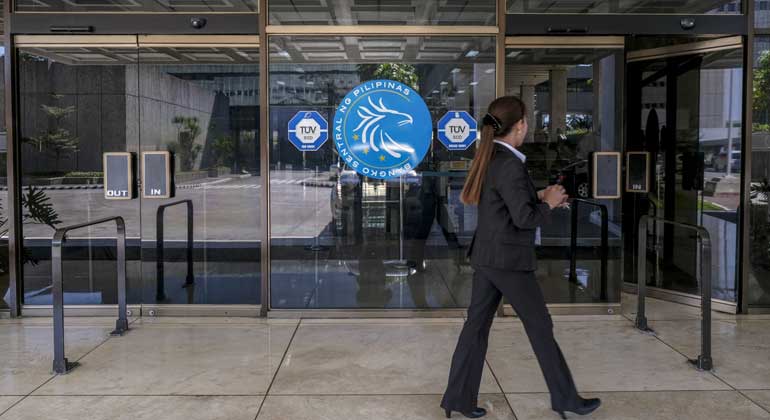
THE Bangko Sentral ng Pilipinas (BSP) on Thursday left its key interest rate unchanged for a second straight meeting, citing easing inflation and ample liquidity in the financial system.
At its fifth policy meeting this year, the Monetary Board (MB) kept the rates on the BSP’s overnight reverse repurchase, lending and deposit facilities unchanged at their record lows of 2.25%, 2.75% and 1.75%, respectively.
“The Monetary Board’s decision is based on the assessment that the prevailing monetary policy settings remain appropriate,” BSP Governor Benjamin E. Diokno said in an online briefing.
While inflation is expected to tread a slightly lower path, Mr. Diokno said it is still projected to remain within the government’s 2-4% target band.
He said the MB also considered the “encouraging signs” of a recovery in the domestic economy, supported by sufficient liquidity. The global economy also appears to have stabilized, although uncertainty remains as coronavirus disease 2019 (COVID-19) infections are still on the rise in some parts.
“Given these considerations, the Monetary Board is of the view that a continued pause will allow prior measures by the BSP to further work their way through the economy. The gradual easing of restrictions, along with sustained efforts by the government to protect human health and livelihood, should also help lift market sentiment and aid the recovery of the economy in succeeding months,” Mr. Diokno said.
A BusinessWorld poll last week showed 14 of 15 analysts expected the central bank to keep interest rates untouched to allow more time for previous measures to work their way into the economy.
“Looking ahead, the BSP stands ready to deploy its full arsenal of instruments as needed in fulfillment of its mandate to maintain price and financial stability conducive to sustainable economic growth,” Mr. Diokno said.
SLOWER INFLATION AHEAD
In the same briefing, BSP Deputy Governor Francisco G. Dakila, Jr. said the inflation forecast for this year was revised downwards to 2.3% from the previous 2.6% estimate due to easing oil prices and lower-than-expected print for August.
The central bank on Wednesday estimated headline inflation to have settled between 1.8% and 2.6% in September. The Philippine Statistics Authority (PSA) is set to report September inflation data on Oct. 6.
Mr. Dakila said they also lowered the inflation outlook for 2021 and 2022 to 2.8% (from 3%) and 3.0% (from 3.1%).
“However, we continue to retain the balance of risks on the downside over the policy horizon from 2020 up to 2022. This owes largely due to the risks of potential disruptions to domestic and global economic activity amid the ongoing pandemic,” Mr. Dakila said.
Meanwhile, Mr. Dakila said the BSP still has enough room to further its reserve requirement ratio (RRR).
“Further reductions in our ratios can be considered by the monetary policy as needed, at this point, that benign inflation environment provides us room for further reductions in reserve requirements if necessary, even as recent indications of financial market activity continue to point to the fact that market liquidity has remained adequate,” he said.
The BSP in April cut big banks’ RRR by 200 basis points (bps) to 12%, while the reserve requirements for thrift and rural lenders were trimmed by 100 bps to three percent and two percent, respectively. The MB has authorized RRR cuts of up to 400 bps this year.
Security Bank Corp. Chief Economist Robert Dan J. Roces said the MB may have considered the prevailing uncertainty over the pandemic in its decision to keep its rates unchanged.
“The central bank clearly is factoring in the still uncertain environment, preserving some conventional ammunition until the third-quarter growth figures are out as it continues to evaluate the transmission of its prior policy actions relative to forthcoming fiscal measures to address the pandemic. This plus good liquidity in the financial system justifies the hold,” Mr. Roces said via Viber.
In a note, Capital Economics economist Alex Holmes said the central bank has not finished its easing cycle for the year since the economy’s recovery seems to be one of the slowest in the region.
“We think more easing is necessary. Gross domestic product (GDP) contracted by 16.5% y/y in the second quarter. While activity is now recovering, the country’s failure to contain the virus is holding back the recovery,” Mr. Holmes said.
For ING Bank N.V. Manila Branch Senior Economist Nicholas Antonio T. Mapa, the MB is unlikely to cut benchmark interest rates in its last two meetings this year since the real policy rate is now in negative territory. — Beatrice M. Laforga
